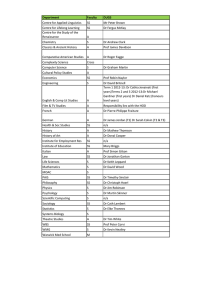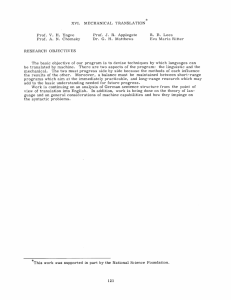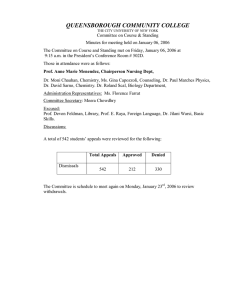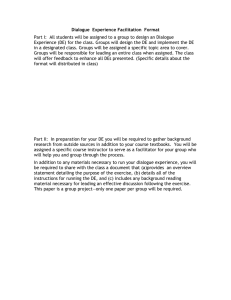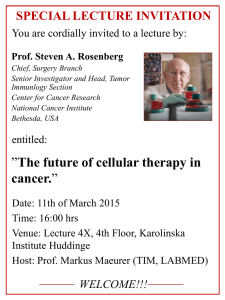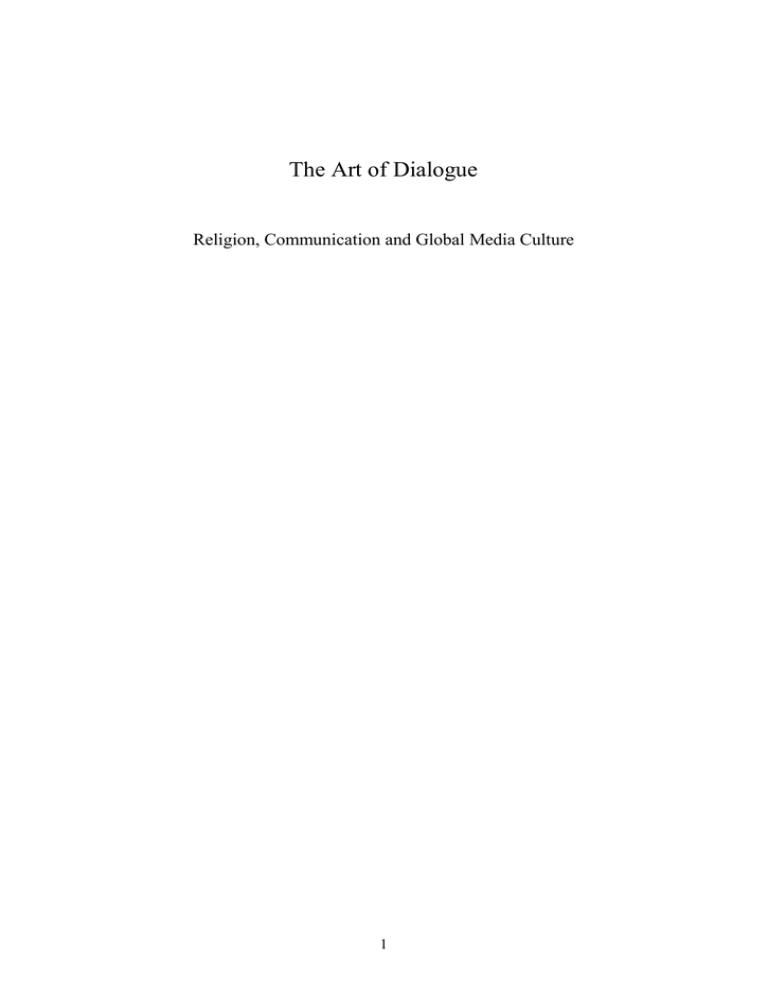
The Art of Dialogue
Religion, Communication and Global Media Culture
1
To Naomi,
Lieven, Amabelle and Jiāo Lίn
The ‘lovelies’ of my life
2
The Art of Dialogue
Religion, Communication and Global Media Culture
Ineke de Feijter
Lit Verlag
3
Serie Religion und Biographie
Redaktion:
Series Religion and Biography
Editors:
Prof. Dr. Detlev Dormeyer (Dortmund)
Prof. Dr. Ruard Ganzevoort (Amsterdam)
Prof. Dr. Linus Hause (Gießen)
Prof. Dr. Friedhelm Munzel (Dortmund)
Copyright © Lit Verlag, 2006.
All rights reserved. No part of this publication may be reproduced, stored in a retrieval system, or transmitted, in
any form, or by any means, electronic, mechanical, photocopying, recording or otherwise, without the prior
written permission of the publisher.
Cover Illustration: H.N. Werkman, The Hasidic Legends, a suite.
By courtesy of Collection Groninger Museum, photo John Stoel (with permission of the Stichting H.N.
Werkman). © Groninger Museum www.groningermuseum.nl
Cover design: Rinus Roepman, Snowball, Middelburg
Lay-out: Elly de Feijter, Projecta, Middelburg
Bibliografische Information Der Deutschen Bibliothek
Die Deutsche Bibliothek verzeichnet diese Publikation in der Deutschen
Nationalbibliografie; detaillierte bibliografische Daten sind im Internet
über http://dnb.ddb.de abrufbar.
Bibliographical Information of the German Library
This publication is registered by the German Library in the German National Bibliography.
A catalogue record for this book is available at: http://dnb.ddb.de
ISBN 3-8258-0050-4
© LIT
VERLAG Münster 2007
Grevener Str./Fresnostr. 2 48159 Münster
Tel.0251-62 03 20 Fax 0251-23 19 72
E-Mail: lit@lit-verlag.de http://www.lit-verlag.de
4
Contents
Preface
Introduction
1. From Broadcasting to Business and Beyond: Media Context and Media Culture
1.1.
The Western European media system(s)
1.1.1.
Structures and players
1.1.2.
Trends and changes
1.1.2.1.
Digitization and convergence
1.1.2.2.
Deregulation, liberalization and privatization
1.1.2.3.
Concentration, globalization and commercialization
1.1.3.
New Media
1.1.3.1.
Patterns of communication and interactivity
1.1.4.
Evaluation
1.1.5.
Summarizing remarks
1.2.
The social cultural role of media
1.2.1.
Defining social reality
1.2.2.
Shared cultural environment and shared identity
1.2.3.
Summarizing remarks
1.3.
The religious dimension of media culture
1.4.
Implications for mainline religion
1.5.
Conclusion
2. The Perception of Audiences: Recent Changes in Communication Theory
2.1.
Communication research shifts: from sender to audience
2.1.1.
Functionalist sociology and information theory
2.1.2.
Semiotics
2.1.3.
Critical Theory
2.2.
The audience research tradition
2.2.1.
The structural approach
2.2.2.
The behavioral approach
2.2.3.
The social cultural approach
2.2.3.1
Audience ethnography
2.2.4 Media culture and the discursive audience construct
2.2.4.1
Views on the audience
2.2.4.2
Views from the audience
2.3.
‘The audience is dead; long live the audience’
2.4.
The choice of paradigm
2.5.
Implications for church communication goals
2.6.
Conclusion
5
3. The Policy-Statements published by the Churches
3.1.
3.2.
3.3.
3.3.1.
3.3.2.
3.3.3.
3.3.4.
3.3.5.
3.3.6.
3.3.7.
3.3.8.
3.3.9.
3.3.10.
3.4.
3.4.1
3.4.2
3.4.3
3.4.4
3.4.5
3.5.
A brief historical overview
Outline of the research
Content analysis
Documents
Media context, structures and media culture
Audience research
Christian identity
Views on communication and media roles
Theological presuppositions
Church involvement in communication
Social and ethical responsibilities
Challenges and priorities
Summary
Inventory of main problems
The outlook on media, communication context and culture
The outlook on the audience and related audience research concepts
Communication models and theological presuppositions
Ecclesiological identity
Implementation and praxis
Conclusion
4. The Art of Dialogue
4.1
4.2
The concept of dialogue
Public space: a condition sine qua non
4.2.1
Social responsibility and media ethics
4.3
The art of dialogue and media culture
4.4
The art of dialogue and the audience
4.5
The art of dialogue and identity
4.6
The art of dialogue and theology
4.6.1
The concept of communication theology
4.7
Conclusion
5. Dialogue: the Art of Thinking Together
Concluding Considerations
Annexes
Appendix one: Global reach of the largest media players
Appendix two: Facts and figures on Internet and www
Appendix three: Initial inventory of the main basic policy statements on media and
communication since the 1960’s
Appendix four: People’s Communication Charter
Bibliography
Index
About the author
6
“Of all affairs, communication is the most wonderful”
John Dewey
7
Preface
‘Of all affairs, communication is the most beautiful’, John Dewey said. He is right. There is
no greater joy than the feeling of being deeply and mutually related to one another in
dialogue, an endless discovery of amazement.
During the formation of this volume, I have been fortunate to experience this joy and
amazement many times, in an academic, professional and personal sense. This has occurred
during discussions with colleagues in international conferences about media, religion and
culture, with students and colleagues in the faculty, and with experienced and admirable
scholars, who were willing to share their wisdom. But it has also happened in meeting people
who dared to open up in both the most beautiful as well as the most difficult times of their
life, sharing deep concerns, far beyond talk. I’m very grateful to all of them.
Communicative joy and amazement however, also can turn into its counterpoint. It was
brutally disturbed on September 17, 2004, the day my whole family was involved in a car
accident. The day of the loss of one of our four children, my dearest Naomi….
She is sheer amazement. Full of life, enjoying, discovering, playing, blossoming out, teeming
with new games and plans. But also mischievous and tender, courageous and shy, a ringleader
and sweet and caring, all at the same time. Every time I look at her pictures on my desk -her
bright twinkling eyes, the dimples in her cheeks and her generous laugh- I realize over and
over again how she lives entirely up to her name: Naomi - the Hebrew word for lovely.
Encouraging she is as well. After her passing away I was not able to continue this volume for
a long time. Until that day when I found her little letter again, with those precious childlike
written words wishing me luck on presenting my first paper at an international conference. It
was boxed in by sweet red hearts, and both our names written all over.
This volume is wholeheartedly dedicated to her - with whom communicating will never come
to an end. And to her brave and caring brother, Lieven, her little sister, Amabelle, who is
trying so hard to be big now, and to her small and cheerful sissy, Jiao Lin. All three of them
live up to their names as well - each also means lovely in Flemish, in French, and in Chinese.
Those names deeply relate all four of them forever. They encourage me in innumerable many
ways with their little gestures, their many hugs, drawings and conversations, and their loyalty
and love. I admire the way they picked up their lives again, their patience, endurance and
lovely support for this undertaking. How proud I am of them is far beyond my ability to
communicate. If it were not for the love of those four, I am not sure whether I would ever
have been able to finish this book, and it fills me with great pride and joy that Lieven
participated in the PhD graduation ceremony as my very special paranimf.
In a way this book is dedicated to my parents as well, who have seen its progression, but
never its completion. Losing both the generation before me as well as part of the generation
after me in such a short period of time, is hard to cope with. I remember both of them with
love, having dedicated their lives to raise their eight children on a small farm.
Many people -in one way or another- have contributed to this volume. I wish to express my
gratitude to all of them. At the risk of incompleteness, however, I would like to mention the
names of some of them in special - in which all are included.
I am extremely grateful to Prof. Dr. Cees Hamelink, who taught me more (and still does) than
he probably realizes. I joyfully remember our many dialogues, of which the amazement
continued to increase even a long time afterwards. I also remember his gentle encouragement
8
months after Naomi died. And his classes that I attended, in order to prepare myself to
become his successor at the Vrije Universiteit Amsterdam - which still fills me with pride.
His many publications and contributions to conferences, in which this rare combination of
both profound scientific and excellent communicative quality converge.
As well as the way he involves his audiences during his presentations, revealing his other
creative competences - being a professional musician as well. Another form of
communication through a variety of instruments that are each given their due, and still
harmonize in dialogue, up to the point that communication is able to transcend itself.
I cherish our warm friendship that has grown over the years.
I also would like to express my extreme gratitude to another highly-estimated, long-term
teacher and now my colleague: Dr. Hanneke Meulink. I came to know her important scientific
contributions to pastoral theology as a student 15 years ago. In the past two years her
excellent, professional pastoral skills, her warm friendship, and her loving care helped me
through those extremely difficult moments when communication seems beyond reach.
Without these hours of dialogue, silence, grief, her patience and careful listening and
encouragement, I would not have been able to reach today’s point.
I would also like to thank Dr. Eddy Van der Borght for his sympathy with this project, and his
thoughtful comments and encouragements during long train journeys when we traveled home
together. A long-standing colleague in Belgian ministry, I rejoiced on our collegial reunion in
the faculty and the intensifying of our friendship.
I could not have wished for two better paranifms who are that close to me.
A number of colleagues in the field either shared their knowledge about communication and
theology or commented on earlier parts or drafts of this thesis. In random order I wish to
thank: Prof. Dr. Franz-Josef Eilers, Prof. Dr. William Fore, Prof. Dr. Paul Soukup, Prof. Dr.
Peter Horsfield, Dr. Hans Wolfgang Hessler, Prof. Dr. Robert White, Prof. Dr. Frances Forde
Plude, Prof. Dr. Clifford Christians, Dr. Jolyon Mitchell, Prof. Dr. Ruard Ganzevoort, Dr.
Wim Noomen, Prof. Dr. Alle Hoekema, Prof. Dr. Birgit Meyer, Prof. Dr. Karel Deurloo, Dr.
Jan Greven and Dr. Albert van den Heuvel. I also want to thank my colleagues of the
department of practical theology and social sciences at the Vrije Universiteit Amsterdam for
the valuable, monthly conversations about our work -including this volume- their support and
pleasant collegiality. I am also grateful for the help provided by all the representatives of the
churches and their institutes who helped me along in the protracted search for policy
statements.
Many people helped me out with ‘practical’, however - very important issues. I would like to
thank Annette Mosher for the accuracy with which she corrected my English, her openness
and empathy.
I also like to express my deep gratitude to Morris Defeyter, my dearest uncle from Canada,
who did (and does) not allow his Parkinson disease to cause him to surrender, nor to keep him
from sending his English language comments. After the loss of Naomi he was the first to
encourage me to continue, which -as he said- ‘would make me very proud’. I therefore
dedicate this work also to him, having been an excellent teacher himself, as a present for his
80th birthday. And thank him for his cordiality and wisdom -which is always communicated
with humor- for the novel about his life, and his lively and witty poems.
I thank Mrs. Liisa Finch, for translating the Finnish documents and Mr. Harry Onzia for the
Swedish translations. Elly de Feijter, who took care of placing all the text in its right lay-out,
and Rinus Roepman, who designed the cover, I thank, for putting their energy and creative
skills into this book. I also would like to thank sister Johanna -cordial as always- from the
9
abbey ‘Onze Lieve Vrouw van Nazareth’ in Brecht (Belgium), whose community kindly
provided me with the silence I needed and a quiet place to study once a week, during the last
year and a half. All computer problems were immediately remedied by Ad, my husband. Part
of his wordless, however enduring interest and support to my work - for which I’m grateful.
I hope this volume will inspire theologians, religious scholars and students in this field to
reflect on media and communication and to dialogue - regardless of whether they agree with
the outcome of this study or not. I also hope it will be a worthy contribution to the
interdisciplinary dialogue between scholars in the field of media, religion and culture and to
media and communication scholars (becoming) interested in the field of religion.
In the Bible there is this beautiful story of a little boy, the youngest of a family of eight. A
nondescript, red-haired, young fellow that dwells in the fields, looking after his father’s sheep.
His three elder brothers all are at ‘the front’. That is to say, they gaze (as does their whole
army), everyday at this gigantic terrifying creature who belongs to the adversary Philistines:
Goliath. This man-to-man fighter ridicules them day after day, by showing himself every
morning and every night, for forty days, on the top of the mountain where both armies are
camped. He scoffs their fear and challenges them to pick out and send one man to fight with
him.
One day, little David is sent by his father to bring bread and cheese to the leader of his
people’s army, and to see if his brothers are all right. On his arrival, Goliath climbs the
mountain again. After having checked how his brothers are, David looks and listens to
Goliath’s scoffing. He also notes the fear of his people. They tell him that the man who
defeats Goliath will become very fortunate. Whereupon, David asks: ‘who for God’s sake is
this Philistine, this uncircumcised, having been allowed to scoff at the battle arrays of the
living God?’ And again his people tell him that the man who defeats Goliath will be
extremely fortunate. David’s eldest brother, overhearing the conversation, flies into a rage,
shouting at David: ‘why for God’s sake did you come? I know your rashness! You just
wanted to come and see the war!’.
To which David answers: ‘What exactly is it, I’ve done? It was only just a question!’1
If this volume might lead to just ask the right questions about (religious) communication, I’d
be more than pleased.
Shuswap Lake, Canada,
Amsterdam, the Netherlands
Summer 2006
1
In the original Hebrew text it reads: a dabar which means: a word. Not just a word, however, but a word in which
the corresponding deed is intrinsically included. Word and deed in this respect cannot be separated. (See also
section 4.2, note 8).
10
VRIJE UNIVERSITEIT
The Art of Dialogue
Religion, Communication and Global Media Culture
ACADEMISCH PROEFSCHRIFT
ter verkrijging van de graad Doctor aan
de Vrije Universiteit Amsterdam,
op gezag van de rector magnificus
prof.dr. L.M. Bouter,
in het openbaar te verdedigen
ten overstaan van de promotiecommissie
van de faculteit der Godgeleerdheid
op woensdag 20 december 2006 om 10.45 uur
in het auditorium van de universiteit,
De Boelelaan 1105
door
Christine Louise de Feijter
geboren te Vogelwaarde
11
promotor: prof.dr. C.J. Hamelink
12
On the author
Ineke de Feijter is Assistant Professor in the masters program on Media, Religion and
Culture at the Faculty of Theology and Religion of the Vrije Universiteit Amsterdam.
Her areas of research and teaching include the religious dimensions in and of global media
culture and the implications for mainstream religions; media and religious conflict; media,
religion and the public sphere; mediation, religious identity and communities and media
culture and care.
She is a member of the international research team on ‘Blasphemy, Sacrilege and the
Sacred, Conflicts Around the Presence and Representation of Islam and Christianity in the
Public Spheres of the Netherlands, Germany and the United Kingdom’, part of the Norface
Research Program on the Re-emergence of Religion as a Social Force in Europe,
(forthcoming 2007).
She studied theology in Amsterdam and Buenos Aires and took her master’s degree (cum
laude) at the University of Amsterdam and her doctoral degree at the Vrije Universiteit
Amsterdam. Her professional career includes both communication (journalism and public
relations) and theology. She was head of the communication department of IKON, the
ecumenical national public broadcaster in the Netherlands, and served the United Protestant
Church of Belgium as a minister.
She authored several articles and papers on the relationship between churches and media
culture among which Mainline Religion and Global Media Culture: Curtain Line or Kairos?
Some Theological Reflections. Louisville, Kentucky, 4th International Conference on Media,
Religion and Culture, 2004.
13

